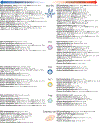Role of Epigenetics in the Regulation of Immune Functions of the Skin
- PMID: 33256976
- PMCID: PMC8068568
- DOI: 10.1016/j.jid.2020.10.012
Role of Epigenetics in the Regulation of Immune Functions of the Skin
Abstract
This review is intended to illuminate the emerging understanding of epigenetic modifications that regulate both adaptive and innate immunity in the skin. Host defense of the epidermis and dermis involves the interplay of many cell types to enable homeostasis; tolerance to the external environment; and appropriate response to transient microbial, chemical, and physical insults. To understand this process, the study of cutaneous immunology has focused on immune responses that reflect both adaptive learned and genetically programmed innate defense systems. However, recent advances have begun to reveal that epigenetic modifications of chromatin structure also have a major influence on the skin immune system. This deeper understanding of how enzymatic changes in chromatin structure can modify the skin immune system and may explain how environmental exposures during life, and the microbiome, lead to both short-term and long-term changes in cutaneous allergic and other inflammatory processes. Understanding the mechanisms responsible for alterations in gene and chromatin structure within skin immunocytes could provide key insights into the pathogenesis of inflammatory skin diseases that have thus far evaded understanding by dermatologists.
Copyright © 2021 The Authors. Published by Elsevier Inc. All rights reserved.
Conflict of interest statement
Conflict of Interest:
R.L.G. is a co-founder, scientific advisor, consultant and has equity in MatriSys Biosciences and is a consultant, receives income and has equity in Sente Inc.
Figures

References
-
- Adoue V, Binet B, Malbec A, Fourquet J, Romagnoli P, van Meerwijk JPM, et al. The Histone Methyltransferase SETDB1 Controls T Helper Cell Lineage Integrity by Repressing Endogenous Retroviruses. Immunity 2019;50(3):629–44.e8. - PubMed
-
- Bar-Sadeh B, Rudnizky S, Pnueli L, Bentley GR, Stöger R, Kaplan A, et al. Unravelling the role of epigenetics in reproductive adaptations to early-life environment. Nat Rev Endocrinol 2020;16(9):519–33. - PubMed
-
- Bartlett AA, Singh R, Hunter RG. Anxiety and Epigenetics. Adv Exp Med Biol 2017;978:145–66. - PubMed

